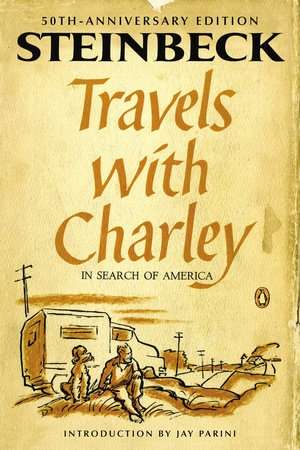Travels with Charley

Editorial Penguin USA
Colección Penguin Classics Deluxe, Número 0
Fecha de edición octubre 2012 · Edición nº 1
Idioma inglés
EAN 9780143107002
240 páginas
Libro
encuadernado en tapa blanda
Resumen del libro
A collectible 50th anniversary deluxe edition featuring an updated introduction by Jay Parini and first edition cover art and illustrated maps of Steinbeck's route by Don Freeman
In September 1960, John Steinbeck embarked on a journey across America. He felt that he might have lost touch with the country, with its speech, the smell of its grass and trees, its color and quality of light, the pulse of its people. To reassure himself, he set out on a voyage of rediscovery of the American identity, accompanied by a distinguished French poodle named Charley; and riding in a three-quarter-ton pickup truck named Rocinante.
His course took him through almost forty states: northward from Long Island to Maine; through the Midwest to Chicago; onward by way of Minnesota, North Dakota, Montana (with which he fell in love), and Idaho to Seattle, south to San Francisco and his birthplace, Salinas; eastward through the Mojave, New Mexico, Arizona, to the vast hospitality of Texas, to New Orleans and a shocking drama of desegregation; finally, on the last leg, through Alabama, Virginia, Pennsylvania, and New Jersey to New York.Travels with Charley in Search of America is an intimate look at one of America's most beloved writers in the later years of his life a self-portrait of a man who never wrote an explicit autobiography. Written during a time of upheaval and racial tension in the South which Steinbeck witnessed firsthand Travels with Charley is a stunning evocation of America on the eve of a tumultuous decade.
Biografía del autor
John Steinbeck (Salinas, 1902 - Nueva York, 1968). Narrador y dramaturgo estadounidense. Estudió en la Universidad de Stanford, pero desde muy joven tuvo que trabajar duramente como albañil, jornalero rural, agrimensor o empleado de tienda. En la década de 1930 describió la pobreza que acompañó a la Depresión económica y tuvo su primer reconocimiento crítico con la novela Tortilla Flat, en 1935. Sus novelas se sitúan dentro de la corriente naturalista o del realismo social americano. Su estilo, heredero del naturalismo y próximo al periodismo, se sustenta sin embargo en una gran carga de emotividad en los argumentos y en el simbolismo presente en las situaciones y personajes que crea, como ocurre en sus obras mayores: De ratones y hombres (1937), Las uvas de la ira (1939) y Al este del Edén (1952). Obtuvo el premio Nobel en 1962.








